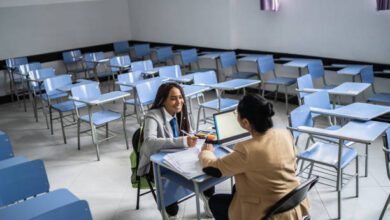The Meaning of Co-Curricular Activities in Urdu for Students


Understanding co-curricular activities in Urdu is a topic that is not often discussed, but it is very important for students. As we all know, education is not limited to the four walls of the classroom. It covers various aspects of the student’s development, including their physical, mental, and social development. Co-curricular activities meaning in urdu are important in teaching these aspects and forming a complete individual. In this blog post, we will delve deeper into the meaning of cooperative activities in Urdu and explore how they can benefit students in their academic journey. So let’s dive in and find the real essence of cooperative activities in Urdu!
To understand the concept of cooperative activities
To clearly understand co-curricular activities or “Ham-Jari Sargarmiya” as it is called in Urdu, we must first separate it from the traditional academic curriculum. While both are important parts of the educational journey, co-curricular activities exist beyond the confines of the classroom, providing a platform for students to develop a variety of skills, connect with peers, and pursue new interests. They are not considered in the academic classes, but they complement the educational process to a large extent.
Whether it’s a drama club a sports team, a debating club, or a community service initiative, these activities create an environment in which students can grow and learn outside of textbooks. They allow students to explore their different personalities, discover hidden talents, and gain real experiences. Indeed, they play an important role in making education a more engaging and enriching journey. So let’s delve deeper into the world of co-curricular activities and explore how they can enhance the learning journey of students, especially those learning in the beautiful language of Urdu.
The importance of cooperative activities in the life of the student
Co-curricular activities are considered transformative in a student’s learning journey. Their influence goes beyond filling the gaps between academic classes. These activities encourage the development of a well-rounded personality, supplementing academic learning with important life skills. They provide dynamic energy to the learning process by developing essential skills such as leadership, teamwork, problem-solving, and effective communication.
For students involved in learning Urdu, the importance of extra-curricular activities will increase. Participating in these activities provides a unique opportunity for students to not only improve their Urdu language skills but also develop a deeper appreciation for the cultural differences within this rich language. Whether discussing social issues in Urdu, acting in a drama set against the backdrop of Urdu literature, or participating in a cultural festival celebrating Urdu traditions, students can fully experience the language. These immersive experiences help strengthen language skills, making learning Urdu a truly engaging and fulfilling endeavor.
Types of cooperative activities and their importance
Many types of collaborative activities can be effectively hacked into an Urdu learning wallpaper. Let’s take a look at some of them to appreciate their unique advantages.
Sports are a popular choice. Not only do they provide a fun and interactive platform for promoting physical health, they also teach valuable lessons about teamwork and sportsmanship. Art and music clubs, on the other hand, unleash students’ creativity. They provide a vibrant space where students can express themselves, develop their creativity, and find lifelong passions.
Debate and drama clubs are particularly beneficial for students learning Urdu. Participating in debates helps students refine their Urdu language skills, expand their critical thinking abilities, and gain confidence in public speaking. Being part of drama clubs exposes students to the richness of Urdu literature and dramatic traditions, besides honing their performance skills and emotional intelligence.
Quiz competitions provide a fun and engaging way to promote cognitive development and academic learning. They challenge students to apply their knowledge, improve their quick thinking, and build their general knowledge.
Community service, while fostering social responsibility and empathy, allows students to make a positive impact in their communities. It also offers them an opportunity to use their Urdu language skills in real-life scenarios, thereby improving their communication abilities.
Lastly, cultural festivals are a feast for the senses. They immerse students in the beauty and diversity of Urdu culture, enhancing their cultural understanding and appreciation.
Each of these co-curricular activities, with its unique benefits, contributes to the holistic development of students. They are more than just extra-curricular pursuits; they are essential components of a well-rounded education, particularly in the realm of Urdu language learning.
Role of Co-Curricular Activities in Urdu Education
Delving into the realm of Urdu education, we can truly appreciate how co-curricular activities meaning in urdu come into play. They act as powerful tools, breathing life into language learning and making the culture associated with Urdu more accessible and relatable. Through participation in Urdu debates and drama, students get the chance to use the language in a practical setting, hence refining their command over it. The language comes alive, as they dissect its nuances, intricacies, and idiosyncrasies.
Similarly, by being part of cultural clubs and festivals, students are not just passive observers but active participants in the vibrant tableau of Urdu culture. They engage with the rich tapestry of traditions, customs, and heritage associated with the Urdu-speaking community. This not only fosters a deep cultural understanding but also cultivates a profound appreciation for the diversity and depth of Urdu culture. Through these experiences, students are not just learning a language; they are living it, fostering a strong connection with Urdu that is both personal and profound. Thus, co-curricular activities hold a vital role in Urdu education, transforming it from a simple transfer of knowledge to a vibrant and immersive journey of exploration.
The Balance between Academics and Co-Curricular Activities
Maintaining equilibrium between academics and co-curricular activities is pivotal to a student’s holistic development. While the value of these activities is undeniable, they should not eclipse the primary focus of academic learning. It’s like a beautiful dance, where each partner must move in harmony, complementing each other without one outshining the other. For schools, this involves designing a comprehensive curriculum that fosters intellectual growth alongside personal development. The emphasis should be on providing opportunities for exploration and growth beyond the classroom, without compromising on the academic rigors.
For students, this balance means mastering the art of time management. They need to learn how to efficiently divide their time and energy between academic studies and co-curricular engagements. Balancing their responsibilities doesn’t just enhance their education but prepares them for life beyond school. It teaches them to manage multiple priorities, develop discipline, and build resilience, skills that will serve them well in the future. Thus, maintaining a healthy balance between academics and co-curricular activities meaning in Urdu is the key to a fruitful and enriching educational experience.
Encouraging Participation in Co-Curricular Activities
Creating an atmosphere that encourages students to actively participate in co-curricular activities is essential in fostering their holistic development. Schools can act as catalysts, inspiring students to step out of their comfort zones and delve into these enriching activities. By providing a diverse range of co-curricular options, schools can cater to the myriad interests of their students, ensuring there’s something captivating for everyone.
Providing the necessary resources and support is equally crucial. For instance, schools can establish dedicated clubs and societies, providing students with the platform and resources to engage in their chosen activities. Additionally, training and mentorship from experienced instructors can equip students with the skills and confidence to fully immerse themselves in these pursuits.
In co-curricular activities play a significant role?
Recognition and appreciation of students’ efforts in co-curricular engagements also play a significant role in promoting active participation. Celebrating their achievements, big or small, can serve as a powerful motivator, encouraging them to strive for excellence and continue engaging in these activities. It instills a sense of pride and accomplishment, fostering a positive association with these activities.
However, encouragement should not only come from the school but also from parents and peers. Parents can support their children by showing genuine interest in their co-curricular pursuits, attending their performances, or even simply providing a listening ear when they share their experiences. Peers can create a supportive community where they cheer for each other, learn from each other, and create shared memories.
In this supportive and encouraging environment, co-curricular activities cease to be an obligation and become a joyful exploration, enticing students to participate actively and enjoy the myriad benefits they offer.
Conclusion
Bringing our exploration to a close, we come to appreciate the inextricable role of co-curricular activities meaning in Urdu in shaping an enriching educational journey, particularly for students engrossed in Urdu studies. These activities serve as a dynamic bridge, connecting academic knowledge to practical experiences, fostering skills that textbooks alone cannot impart. In the vibrant world of Urdu education, they offer an immersive environment for students to live the language and its associated culture, enhancing their linguistic proficiency and cultural understanding.
Striking a harmonious balance between academics and co-curricular pursuits empowers students to navigate their educational journey with enhanced confidence and enriched perspectives. After all, education is not just about acquiring knowledge, but about nurturing individuals who are versatile, resilient, and ready to embrace the myriad challenges and opportunities that life presents. Co-curricular activities, indeed, are the keys that unlock this holistic growth, making education a truly comprehensive and fulfilling voyage.



